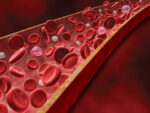Measuring blood cholesterol may help in early diagnosis of SSc: Study
Higher cholesterol linked to lower risk of scleroderma in South Korean study
Written by |

People with more circulating cholesterol — a type of lipid (fat) that plays an important role in the body — may be at a lower risk of developing systemic sclerosis (SSc), according to a study of nearly 10 million people living in South Korea.
Based on these findings, researchers suggest that a person’s lipid levels, which can be profiled from a blood test, may tell how likely that person is to develop SSc, which could help in early diagnosis.
The study, “Association Between Lipid Profile and Risk of Incident Systemic Sclerosis: A Nationwide Population-Based Study,” was published in the journal Clinical Epidemiology.
Lipid alterations common in people with SSc
In people with SSc, overactive immune cells lead to symptoms such as hardened, thickened skin and potentially scarring in internal organs. What drives this to happen is unclear. While lipid alterations are common, it is not known if they are linked to the development of SSc.
To know more, the researchers drew on data from 9,894,996 people who did not have SSc when they underwent a regular checkup in South Korea in 2009, and followed them until 2019.
Over a mean of 9.2 years, 1,355 people developed SSc, which translated into an incidence (new cases) of 1.49 per 100,000 person-years. Person-years is a measure that accounts for the total number of patients and the amount of time each person spent in the study.
More women than men developed SSc (1,118 vs. 237). On average, people who developed the disease were older than those who did not, both women (51.9 vs. 48.8 years) and men (52.4 vs. 46 years).
As part of the checkup, cholesterol was measured in the blood. Cholesterol travels in the bloodstream in lipoproteins. High-density lipoprotein (HDL) carries cholesterol to the liver to be removed from the body, whereas low-density lipoprotein (LDL) helps cholesterol to build up in fatty deposits.
Average high-density lipoprotein cholesterol (HDL-C) was significantly lower in women who developed SSc than in those who did not (56.4 vs. 59.7 mg/dL). In men, there was no difference in HDL-C, but both total cholesterol (187.7 vs. 194.2 mg/dL) and low-density lipoprotein cholesterol or LDL-C (104.7 vs. 112 mg/dL) were significantly lower in those who developed SSc.
Total cholesterol could be used to identify individuals at high risk of SSc
Overall, people who had higher total cholesterol, HDL-C or LDL-C, had a slightly lower risk of developing SSc. The risk was even lower for women and those who were not obese or diabetic.
“In this large population-based cohort [group] study, we found that levels of TC, HDL-C, and LDL-C were inversely associated with the risk of incident SSc,” the researchers wrote.
Lipid-lowering medications, such as statins, also work by reducing inflammation. In the study, however, the use of statins did not influence the association between HDL levels and the risk of developing SSc.
While more research is needed to understand why these associations may exist, “our findings suggest that levels of TC, HDL-C, and LDL-C could be considered in detecting individuals at high risk of incident SSc,” the team concluded.




